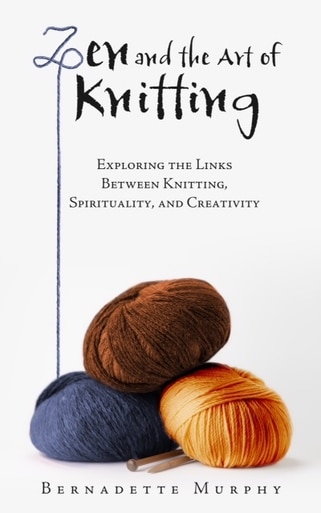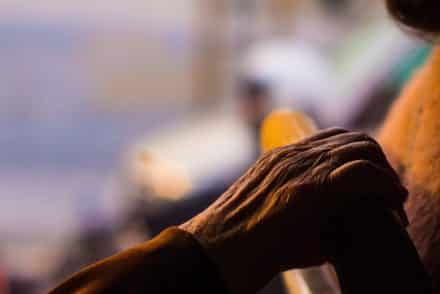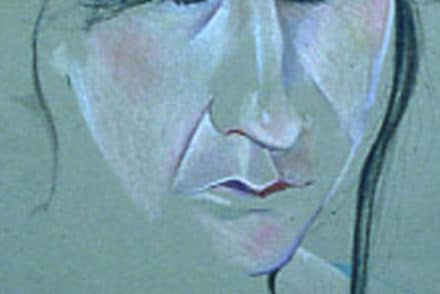By Bernadette Murphy
My twelve-year-old son, Jarrod, plays trumpet in a jazz group, and I’m usually the one to take him to the rehearsals in downtown Los Angeles. Often, I bring a knitting project to work on during the two or three hours he’s behind closed doors. A few other parents wait with me, though most drop their children and return later. The kids work with their jazz teacher in an almost completely soundproof room. When a piece they’re practicing becomes particularly loud, the slightest vibrations and melody slip through the soundproofing like smoke signals to let us know something wonderful is occurring in that little room. Hearing those sounds, I sneak up to the small five-by-ten-inch window and peer in.
I’m not the only one. Passersby, parents, people waiting for their dance classes to start: we all take turns jostling to watch preteen kids blow inspired, improvised jazz and blues. There’s something irresistible about watching people do something they love.
The rehearsals take place in a gorgeous performing arts school situated next to the Museum of Contemporary Art (MOCA), a stone’s throw from the Music Center’s Dorothy Chandler Pavilion and in the shadow of the amazing Disney Concert Hall, standing at astounding angles, huge sails of metal and concrete reminding Angelenos of imagination’s incredible power. The school is located in an area that’s both highly cultured and adjacent to great poverty; skid row is a few blocks away. It’s a place where art, music, and dance–self-expression of all forms–are actively encouraged and yet the implicit risk in such self-expression is tangibly present. The unspoken fear, at least among the adults, seems to be: If I give myself so fully to something I love, will I end up like that street-corner poet I passed while looking for a parking space? The woman was screeching her words at approaching vehicles, trying to call attention to her beliefs and experiences, only to be drowned out by the forward-marching parade of society. Or what about the homeless man outside MOCA, strumming his guitar, happy in his music yet oblivious to the rest of the world: Will I become like him?
One of the biggest dangers of giving in to art is that our values might change—or return to an earlier, simpler form. The perfect house, the right furniture, the great job, the designer clothes: Maybe those things don’t represent our hearts’ desires the way we thought. Maybe we’ll learn something about ourselves that we didn’t particularly want to know. Or maybe people will laugh at us. Maybe we won’t appear the way we’d like to.
Worse yet: Maybe we won’t be any good at what we love.
And yet, those who indulge their talents so lavishly attract us all. It’s one of the reasons our society is obsessed with celebrities. We’re drawn to the energy produced by talent, by concentration, by hard work in the face of uncompromising odds. As I sit outside the jazz rehearsal room listening to the cadence of the tap dancers next door meld with the bleats of saxophones and the quiver of piano chords, I can’t help thinking there’s something wonderfully old-fashioned about people who will spend hours upon hours practicing a particularly difficult shuffle-step or learning to play a scale pocked with sharps or flats, bringing to life musical transcription that predates the city. This hard work, dedication to craft, and willingness to persevere as the learning curve gains intensity is undeniably attractive. Maybe that’s in part because such qualities are rare these days.
Today, we can play basketball on an iPad and experience all the satisfaction of scoring without ever holding a tangible basketball in our hands and feeling its heft, without having to try and fail and try and fail, and without ever feeling our shoulders grow sore from the effort and our feet hot from pounding the pavement. Who wouldn’t choose the virtual over the asphalt court outside? No need to get sweaty and dirty. Similar satisfactions are available to all of us in digital formats. Music is a flip of a switch away—on our phones and iPods, the radio, and CDs—and dance has become yet another way to sell us products. Why read good books when Hollywood will give you an easy-to-swallow film adaptation? By the same token, why take the time and energy to knit a sweater when you can buy five factory-produced ones instead? Why put yourself through the paces of creation, all that work? The celebrities in our culture are there to save you from that effort, the media tell us, to save you from the fear of embarrassment, the hassle, the grind.
Unfortunately, they also save us from exploring ourselves, from finding the talents that are lurking within, just waiting for a chance, and from finding the unspeakable joy in creating something with our own hands, minds, and bodies.
Next door to the jazz room is the tap-dance studio. When the tap dancers get going, everyone in that part of the building is drawn to the long landscape window that overlooks the scuffed-wood floor. Shouldered together, we, the impromptu audience, become mesmerized by the beat of the dancer’s feet, the thrumming of the music, the synchronized movement of the students. Like a flock of birds turning all at once or the symmetry of waves pulled upon the shore, their motion entrances and calls for attention. For the first time that day, perhaps, we become aware of our own heartbeat. Our feet start moving just a toe at a time, our hands beat out a corresponding rhythm on our thighs. Something calls us to join in. And yet we usually content ourselves to watch, feeling a vague happiness at seeing others so fully exploring themselves. Dancers arc and curl and move in perfect cohesion, as the rest of us, spectators at this celebration of life, watch for five or ten minutes before moving on, usually mumbling as we go, “I wish I could do that.”
I look from the studio to the stitches in my hand. When I’m waiting outside the jazz room and knitting, invariably one of the other parents—usually a mother—will check out the project I’m working on, comment on how lovely it is, and tell me how she’s never been able to knit. She might share a story about being taught in Girl Scouts in seventh grade, but explain how she never got the hang of it. The conversation, regardless of the person making the comment, usually ends on the same note: “I wish I could do that.”
Over the countless weeks I’ve been ensconced in the halls of this performing arts school, amazing things have begun to happen-or maybe they’ve been happening all along and I’m only just now noticing. A few of the parents who’ve watched the tap dancers have recently signed up for tap dancing lessons themselves. They’ve embraced an important truth: You don’t have to be a kid to enjoy dancing. Or as the novelist Tom Robbins put it: “It’s never too late to have a happy childhood.” Even those adults who are older and have two left feet realize they can get out there on that very same floor that the professionals-in-training use; they can have a go at it. They won’t look as coordinated as those incredibly talented youngsters, but who cares? It’s their life. The beat is calling. Their feet are tapping. The smile of childhood splits the tension in their face. The time is now. Dance.
Children who’ve watched me knit often ask if I’ll teach them how. Children seem less afraid to try something new than most adults, but that may be changing as well. Adults have begun asking, have become willing to take the risk. Maybe we’ve grown tired of letting television stars have all the fun.
Ironically, though, the interest among young knitters can be traced to the increasing numbers of knitting celebrities. If Dakota Fanning, Kate Middleton, Sarah Jessica Parker, and Christina Hendricks like it, the thinking seems to go, maybe I will, too. There’ve been blurbs online recently about David Arquette, Uma Thurman, Ashton Kutcher, and other needle-wielding celebrities, demonstrating to readers just how hip knitting has become.
But I think the trend goes deeper than simple celebrity imitation. My theory is that we’ve grown so tired of looking and dressing and thinking the same—buying our coffee at Intelligencia and wearing our boyfriend jeans from Rag & Bone, cutting our hair like Emma Stone or Taylor Swift and going out to the multiplexes to see the same movies—that we’re hungering for some way to show our originality.
In a quieter way than the performing arts, perhaps, knitting is attractive and soul-feeding. It’s original. Its focus is to create something one-of-a-kind. If you ever knit in public, you’ll see that many people stop to stare. People ask questions, initiate conversation, follow your movements. Some sit down just to hear the clack, clack, clack of the needles and be lulled by the physical rhythm of your hands.
My son’s jazz group will give their first performance of the semester this afternoon, making music on the same stage where such luminaries as Wynton Marsalis and the Los Angeles Chamber Orchestra have performed. Everyone in the family has dressed up, and we’ve invited the in-laws and some friends to come along. I sit in the concert hall noticing the near-perfect acoustics of the room, feeling a fluttery anxiousness. The seats are sparsely filled. The flyer that had been sent out to announce the concert listed no specific time, though I’m not sure if that omission is solely to blame for the low turnout. The intimate hall is less than a quarter occupied. How sad, I think, that this first concert is such a nonevent.
The lights dim, the kids come on stage looking small and timid, but the music they create is beyond wonderful. I look around at the in-laws and friends we’ve brought along. They’re enjoying the music, but clearly they’re not seeing and hearing what I am. They see and hear a handful of kids blow some nice tunes through a heavy veil of shyness, kids who are working together in a kind of stilted harmony, making accomplished music but looking throughout like the awkward ingenuous children they are.
I see in their performance all the moments that have led to it. The hours of practice instead of TV or iPod time. The moment my son decided to drop the football team because it was interfering with his music. The rehearsals the kids themselves organized (sometimes I sat in) —six twelve-year-olds crammed into a tiny practice room. They’d figure out how’d they’d perform a given piece: who’d solo first, how they’d come back to the melody, who’d set the tempo, how they’d end. The first time Jarrod soloed with this group of kids, they encouraged him, egged him on. I witnessed the recognition click that day when he realized he could make his own music—not just the music he could read, but the music he could imagine. Miles Davis once said that his job wasn’t to read the notes that were printed on the page, but the notes that weren’t on the page.
Sitting in the concert hall, I realize that they’ve already given the big performance. Over a series of days, stuck in the cramped rehearsal room, a baseball cap sitting backwards on my son’s head. Those were the important times. Today’s performance with everyone all dressed up is no more than a formality, a confirmation of what has already occurred.
What I’ve come to know about knitting and writing and most everything else that matters a great deal to me applies as well to my son’s music. I look at sweaters I’ve made and I don’t see a garment; I see the tough time I had figuring the neck out. The way the multicolored ribbing drove me to distraction trying to understand how to make it work. The way I unwound the hanks of wool when they first arrived, feeling the lanolin and drinking in the colors, imagining what the finished sweater would look like. Once the sweater was done, though, the process was over. Sometimes, the finished product didn’t live up to my expectations, just as today’s jazz performance—the lack of attendance, the unimpressed nature of the audience—didn’t live up. Few things in life ever satisfy our expectations. And yet, in other ways, my pleasure goes so far beyond my expectations: learning a new stitch; discovering a different manner of reducing for shoulders; creating an alternate way of piecing a sweater together. Those were the real moments. And in doing so, I have created something beautiful, something original–a piece of wearable art that has never existed before.
When I hold a finished sweater in my hand, I hold tangible proof that I know more than I think I do and that I’m intelligent. As my dear friend Nancy—who, as a single mother of four girls, went back to college, made it through medical school, and is now a family practice physician—used to remind me: Intelligence isn’t having all the answers. Intelligence is the capacity to learn what you don’t know. The sweaters I knit remind me of this. They remind me that life is too short to stand outside the window of the tap dancing studio saying, I wish I could do that.
# # #
Bernadette Murphy writes about literature, women, risk taking, and life — from motorcycles to knitting. She has published three books of narrative nonfiction: the bestselling Zen and the Art of Knitting (from which this essay is excerpted); The Knitter’s Gift; and The Tao Gals’ Guide to Real Estate). Her newest book, Look, Lean Roll: A Woman, A Motorcycle, and Plunging into Risk, will be published in Spring 2016. She is an Associate Professor in the Creative Writing Department of Antioch University Los Angeles and a former weekly book critic for the Los Angeles Times. Her website is Bernadette-Murphy.com.

Join Jen and Emily Rapp at a writing and the body retreat in Stowe, Vermont Oct 2015. This will be their 3rd one together in Stowe. Click the photo to book.






No Comments